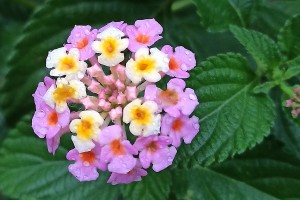Lantana blister rust
History in New Zealand
Lantana blister rust (Puccinia lantanae) is a common leaf pathogen which has been recorded from around 60 plant species including 24 species of lantana in the Neotropics. Permission to release in New Zealand an isolate of this rust from Peru, that is largely restricted to Lantana camara, was granted by the EPA in 2012. This isolate was imported from the UK in March 2013 and the first releases were made in autumn 2015. Establishment has not yet been confirmed from the limited releases made. This rust has never been used as a biocontrol agent anywhere before.
Lantana blister rust has been released in conjunction with the lantana leaf rust (Prospodium tuberculatum). The temperature and moisture requirements of these two rust species are different so they are expected to operate in slightly different climate zones or micro-climates in the field. But in both cases, the climatic requirements for the rusts are typical of those prevailing in lantana habitats here.
How would I find/recognise it and what is the lifecycle?
Leaf and stem chlorosis should be visible 7-10 days after successful infection followed by the appearance of large dark pustules on the stems and underside of the leaves. Once infection is established in the plant, stunted shoots and branch dieback should be visible. The rust is likely to persist throughout the year, at times without noticeable symptoms, and be more prevalent when conditions are most optimal, in autumn and spring.
Image: lantana leaf with blister rust.
Image: lantana plant with blister rust.
Lantana blister rust is a microcyclic rust: it only needs two spore types (basidiospores and teliospores) to complete its life cycle and it is autoecious meaning it has one main host.
Basidiospores infect leaves, petioles and/or stems of actively growing lantana and the affected tissues become chlorotic (yellow). Teliospores then form under the epidermis which eventually ruptures allowing spores to emerge. Teliospores germinate under conditions of high humidity and a fine layer of basidiospores forms on their surface. The rust spreads to new host plants via these basidiospores, mostly by air currents and gravity, and the cycle repeats. As the disease progresses, leaves drop off the plant, stems die back and accumulate areas of dead tissue (cankers).
The only fungus you might confuse with the lantana blister rust is the lantana leaf rust which has much smaller pustules.
See Lantana leaf rust.
Will it attack other plants?
Lantana blister rust is largely restricted to Lantana camara (pink and orange flowered forms). In tests under ideal conditions, some spores were formed on Verbena officinalis, which is occasionally grown here as an ornamental, but research has shown that the rust cannot persist on this species. We therefore expect some minor spill-over damage might occur on V. officinalis where it is growing very closely to infected lantana. From the test results, we anticipate that damage to other ornamental Verbena hybrids will be minor, if it occurs at all.
How effective is it?
It is too early to know how effective lantana blister rust will be in Zealand. Field observations in South America suggest that this rust will prefer, and may be restricted to, warmer wet areas in the far north. The aim of our biocontrol programme is to reduce the ability of lantana to grow, shade out desirable plants, produce seeds that can be spread by birds, and invade new sites. At the very least, defoliation by the lantana rusts is expected to reduce the growth rate of the weed and reduce fruit production.
How can I get the most out of it?
Lantana blister rust can infect lantana plants most effectively at temperatures between 17 and 22°C. It also requires at least 5 hours of leaf wetness from rain or dew to infect plant tissues, but greater exposure increases the level of infection. Releasing the pathogen in early autumn or late spring, when temperatures are most favourable and rainfall is higher, will be more conducive to its establishment. Once a plant is infected, the rust can reproduce relatively quickly and disperse by wind, but some subsequent redistribution efforts may be required if natural infection does not occur in all areas where the rust is needed.
How do I select a release site?
Read Guidelines for selecting release sites for biocontrol agents.
Lantana blister rust prefers warm and humid sites and is best suited to more northern New Zealand sites. Since this rust requires 5 hours of leaf wetness to germinate and infect, release sites should be protected from drying out. Sites in gullies and under canopy will retain moisture for longer. They should also be as safe as possible from frost, fire, flood and human interference such as spraying and slashing. The lantana plants at the site must be the susceptible pink-flowering varieties, not wilting, and actively growing. If possible, the release site should be part of, or close to, a large infestation of lantana to facilitate subsequent rust spread.
How do I collect it for release at other sites?
Potted lantana plants with actively growing leaves should be placed underneath infected plants out in the field. Once these plants become infected with the rust, they can be transferred and planted out to other sites. Note that if you wish to move lantana plants around in this manner you will need an exemption from the Ministry for Primary Industries.
How do I manage the release sites?
Avoid any activities that will interfere with the rust, such as herbicide application. If you need to undertake control measures, then avoid that site.
